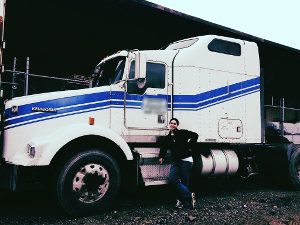Two Questions I Got Confused On...
Topic 16957 | Page 1
On stopping, your total stopping distance is: perception distance + lag distance + stopping distance = total stopping distance.
So your perception distance is the time it takes your brain to recognize the hazard (need to stop).
Your lag distance is the time it takes from when you apply the brakes until the brakes actually begin to stop the vehicle.
Finally the stopping distance is how long it takes the vehicle to stop.
So combining those 3 factors you get your total stopping distance of at least 419 feet.
On your 3 reflective triangles: on a 2 lane undivided highway you will place one 10 feet in front, another one 10 feet behind, and the last one goes 100 feet behind.
If you are on a divided highway, your reflective triangles will go 10 feet behind, another at 100 feet, and the last one will depend on if there is a hill or something obstructing approching vehicles from seeing your disabled vehicle, but should be 200-500 ft behind. 200 feet if no hill or obstruction I believe. Lol seems like forever since i took my permit tests.
HOS:
Hours Of Service
HOS refers to the logbook hours of service regulations.
Your actual commercial written exams may vary per state. While the training materials here are the most useful I have found, there can potentially and probably will be questions on the actual state exams that were not covered here. I took the gen knowledge, airbrakes, combination and passenger written exams yesterday (in Alaska) and you can bet each test had questions that weren't in the pretests available here on TT. They are a great tool to gauge where you are at and help to fine tune your knowledge. But of course always reference/read your states CDL Manual. I would advise leafing through the state cdl manual one more time prior to taking your tests and reciting to yourself a couple of things you may have had trouble remembering.
Lag distance = reaction distance for sues description. same thing :D
I'm not sure where the 290ft is coming from, I'm honestly trying to find it :( From the CDL Manual: Perception distance. The distance your vehicle travels, in ideal conditions; from the time your eyes see a hazard until your brain recognizes it. Keep in mind certain mental and physical conditions can affect your perception distance. It can be affected greatly depending on visibility and the hazard itself. The average perception time for an alert driver is 1¾ seconds. At 55 mph this accounts for 142 feet traveled.
Reaction distance. The distance you will continue to travel, in ideal conditions; before you physically hit the brakes, in response to a hazard seen ahead. The average driver has a reaction time of ¾ second to 1 second. At 55 mph this accounts for 61 feet traveled.
Braking distance. The distance your vehicle will travel, in ideal conditions; while you are braking. At 55 mph on dry pavement with good brakes, it can take about 216 feet.
Total stopping distance. The total minimum distance your vehicle has traveled, in ideal conditions; with everything considered, including perception distance, reaction distance and braking distance, until you can bring your vehicle to a complete stop. At 55 mph, your vehicle will travel a minimum of 419 feet. (142+61+216)
CDL:
Commercial Driver's License (CDL)
A CDL is required to drive any of the following vehicles:
- Any combination of vehicles with a gross combined weight rating (GCWR) of 26,001 or more pounds, providing the gross vehicle weight rating (GVWR) of the vehicle being towed is in excess of 10,000 pounds.
- Any single vehicle with a GVWR of 26,001 or more pounds, or any such vehicle towing another not in excess of 10,000 pounds.
- Any vehicle, regardless of size, designed to transport 16 or more persons, including the driver.
- Any vehicle required by federal regulations to be placarded while transporting hazardous materials.

I've always loathed the triangle placement questions ha ha. Honestly in my opinion it doesn't really matter which one you choose for the undivided 2 lane road w/ traffic both directions, so long as you are on the right side of the road I would put my 10' triangle on the rear corner unless for some reason like maybe some lighting or some sort of obstruction blocked oncoming traffics view from seeing me there like, a large sign or maybe the lighting behind me is better like if I was facing away from a sunset or sunrise? Then I'd say front. Really for now just remember it's either or not both and the 100' in front and behind.

OOS:
When a violation by either a driver or company is confirmed, an out-of-service order removes either the driver or the vehicle from the roadway until the violation is corrected.
New Reply:
New! Check out our help videos for a better understanding of our forum features

















Preview:









 TT On Facebook
TT On Facebook
Tomorrow I'm taking my CDL permit test (yes I was suppose to take it before but things beyond my control came up that day and I was unable to take it), so I was brushing up on my CDL Practice Tests and came across two two questions that confused me. I'm likely reading them wrong, but I'm hoping someone can help me understand because I'm sure they'll both come in handy someday.
--First Question-- Q) A tractor trailer traveling 55 mph will travel how far between when the brain perceives a hazard and stopping? A) At least 419 ft (My Answer) 60 feet
From The CDL Manual: At 55 mph it will take about 6 seconds to stop and your vehicle will travel the distance of a football field (60 + 60 + 170 = 290 feet).
-So from the manual shouldn't the answer be only 290 feet not at least 419?
--Second Question-- Q) When parked on the side of a two-lane road carrying traffic in both directions, place warning devices: A) within 10 feet of the front or rear corners to mark the location of the vehicle and 100 feet behind and ahead of the vehicle, on the shoulder or in the lane you are stopped in
From The CDL Manual: On a two-lane road carrying traffic in both directions or on an undivided highway, place warning devices within 10 feet of the front or rear corners to mark the location of the vehicle and 100 feet behind and ahead of the vehicle, on the shoulder or in the lane you are stopped in (see Figure 2-9 on page 28).
-Alright I think see my mistake on this one but I'm going to post anyway to make sure my mistake is that I think it is. You're suppose to carry 3 red reflectors but if you put one in the at the front and rear corners that 2, then one 100 feet behind and ahead of the vehicle that'll be 2 more for a total of four. Having re-read the question while posting it I see "10 feet of the front -or- rear corners" it being or and not and takes it down to just 1 reflector, but if that is the case how do you know when it put it in the front or to put it in the back?
CDL:
Commercial Driver's License (CDL)
A CDL is required to drive any of the following vehicles: